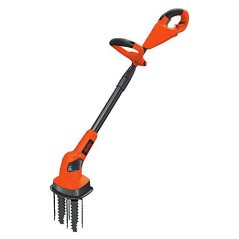BestReviews is reader-supported and may earn an affiliate commission. Details

Powerful tiller comes ready to use with battery pack.
Comes with one lithium ion battery, battery charger, and operating instructions. Covers 325 square feet with fully charged battery. Features adjustable handle and telescoping tube. Soft grip handle offers comfort. Oscillating tines keep weeds from tangling.
This is the most expensive option. Do not purchase this model if you already have a compatible battery pack.

Best option for the owner of multiple Black and Decker products.
Covers up to 325 square feet with each battery charge. Completely cordless power. Small enough to maneuver between flower beds. Battery is interchangeable between other Black and Decker products. Oscillating tines keep weeds from tangling.
This item does not come with the required 20-volt lithium-ion battery.

This lightweight model is great for small jobs around the house.
Long tines reach deep into flower beds, lawns, and gardens. Hardened steel tines won't rust. Design prevents weeds from tangling. Tines are removable for easy clean up. Lightweight and easy to maneuver in small spaces. Features adjustable handle and telescoping tube.
The cord keeps gardeners confined to areas around a power source.

We recommend these products based on an intensive research process that's designed to cut through the noise and find the top products in this space. Guided by experts, we spend hours looking into the factors that matter, to bring you these selections.

If you plan to plant flowers or start a garden, a tiller can help you prepare the soil. These outdoor machines feature oscillating metal tines that dig down into the earth to break up hard dirt. In so doing, you create a suitable and fruitful environment for flowers and plants to take root and grow.
BLACK+DECKER makes lightweight, easy-to-use tillers that are powered by electricity instead of gas. Like most of the company’s lawn care items, BLACK+DECKER tillers are easy to maintain, store, and use. Some of the best tillers used by homeowners and avid gardeners are BLACK+DECKER products.
This buying guide introduces the basics of tilling and explains how a BLACK+DECKER tiller may help you obtain the lawn and garden of your dreams. BLACK+DECKER tillers offer some distinct advantages you’ll want to know about. To learn about the perks as well as other notable characteristics, keep reading.

The purpose of a tiller is to break up hard soil in order to create a patch of land where you can plant, garden, and grow. You may use one to get rid of weeds and grass before planting or to set up soil properly for seeding. A tiller aerates the soil, making it easier for roots to embed and water and nutrients to travel where they’re needed.
You won’t need to use a tiller often over the course of a year, but it’s an important tool for creating a beautiful and healthy garden. A shovel can dig up soil, but it won’t mix it and break it up evenly like a tiller can. A rake can even out soil, but it won’t dig very deep. A tiller is the tool of choice for setting up a garden.
There are a few distinctions to note when choosing a BLACK + DECKER tiller.
Size: BLACK+DECKER tillers are lightweight and handheld. They are relatively small compared to tillers from some other companies, and they may struggle with exceptionally hard ground. BLACK+DECKER does not sell large tillers on wheels that are used on bigger plots. Instead, it sells tillers that are ideal for small to medium-sized areas.
Versatility: Tillers and cultivators are similar but slightly different tools. A tiller is a tool used to break up hard soil, whereas a cultivator is generally a smaller device that loosens soil for planting. As a result of their small size, BLACK+ DECKER tillers perform double duty. They can also serve as cultivators and in fact may be marketed with one or both names.
Power source: BLACK+DECKER tillers use electricity rather than gas. While gas tillers can be large and powerful, they contribute to air and noise pollution. The electric options from BLACK+DECKER are quiet, affordable, and easy to use and store. These machines have a much smaller carbon footprint than their gas-fed counterparts.
BLACK+DECKER tillers are two-handed tools weighing 8 to 10 pounds. While other companies offer heavy-duty wheeled tillers that are large, cumbersome, and must be pushed across the ground, BLACK+DECKER tillers do not have wheels.
A 20-volt battery on a BLACK+DECKER tiller boasts enough charge to cover around 325 square feet of garden. After that point, you would need to stop and recharge the battery.
Because they are generally smaller than tillers made by other companies, BLACK+DECKER tillers also feature shallower tines. Most tillers feature a depth capacity of 4 or 6 inches, which is ideal for planting herbs and flowers but not larger shrubs and trees.
There are two ways BLACK+DECKER tillers are powered: by plugging into an outlet or with a lithium-ion battery. Corded options tend to be cheaper but are also more inconvenient; you’ll need an extension cord and a place to plug it in. You’ll also be subject to the area the extension cord can reach. Battery-powered options cost more upfront, but you’ll likely save money and energy over time. The battery life of a BLACK+DECKER tiller may be anywhere from 20 to 60 minutes, at which point you’d have to recharge.
Most BLACK+DECKER tools work on battery power, so if you already own some of the company’s products or plan to invest in more, you may be able to use the same battery across multiple items (provided the voltage is the same). Notably, the initial investment in a battery and charger may be high.
With regular use, most batteries last three to six years. It’s recommended that you remove a battery from its charging station once it’s fully charged. It’s also good practice to occasionally run the battery until it’s fully drained before charging it again. Store the battery and its charger in a cool, dry place.

Some BLACK+DECKER tillers offer a degree of adjustability in order to make using it as comfortable as possible. For example, you may be able to adjust the grip so the tiller is safer and easier to hold. A telescoping tube can change lengths to cater to your height and workload.
Like many BLACK+DECKER items, a tiller can be purchased in a bundle that includes accessories. For example, you may have the option of buying the tiller with a battery and charger. Some bundles include a spare battery on top of that.
Bundled items usually cost less than they would if you purchased them separately. A bundle is an especially wise investment if you plan to buy more BLACK+DECKER items that run on rechargeable battery power in the future.
Consider adding more than one BLACK+DECKER lawn care item to your collection, as you can often use the same battery across different devices.
Lawn edger: BLACK+DECKER Lithium Ion String Trimmer
Edgers and trimmers create and maintain a distinct boundary for your lawn and garden. We recommend this lightweight battery-operated option from BLACK+DECKER.
Hedge trimmer: BLACK+DECKER Cordless Hedge Trimmer
Another important component to a well-maintained greenspace is the hedge trimmer. BLACK+DECKER makes this simple yet powerful cordless option to add to your collection.
Garden tool organizer: Picnic at Ascot Garden Tote
Keep all your gardening tools conveniently at hand with an organizer. We like this durable and colorful option from Picnic at Ascot that will make gardening much easier.
Garden fertilizer: Osmocote Smart-Release Plant Food
Once you’ve set up your garden bed with a tiller, help your plants grow with proper fertilizer. This option from Osmocote is inexpensive and effective.

Inexpensive: For under $75, you can buy a BLACK+DECKER tiller, but it won’t come with a battery for the charger.
Mid-range: Spending between $75 and $125 will get you a quality tiller that includes a battery and charger.
Expensive: BLACK+DECKER tiller and cultivator bundles cost over $125 and include useful accessories and features.

A. After use, wash dirt and weeds off your tiller. You can use a hose to spray down the tines; some models feature removable tines for easier cleaning. The tines will slowly dull over time, so you will eventually want to sharpen them. You can sharpen them yourself if you have the right tools, or you can take them to a shop for sharpening. Store your tiller tool in a cool, dry place like a garage or shed.
A. Tillers are relatively safe, but you should always be careful with using one, as the tines are sharp. Wearing gloves will protect your hands from flying debris and may also make the device more comfortable to hold. Goggles may be useful, especially if you hit pebbles or roots. Wear the proper footwear as well. On hotter days, stay hydrated, and wear sunscreen to protect your skin.
A. Yes, over-tilling may damage the soil by working it too much and disrupting the nutrients and growth in it. Some gardeners forgo tilling altogether. If you’re using a tiller near plants that are already established, be careful not to disturb their roots. Remember that roots can extend deep down and wide, so it may be hard to tell where they end up.
Tilling wet ground can also damage soil, ruining it’s texture and structure. When going over a new plot of land, till at a shallow depth before retracing your steps and going a little deeper the next time. This keeps the soil even and makes the work more efficient.
Get emails you’ll love.
Learn about the products you’re wondering if you should buy and get advice on using your latest purchases.
